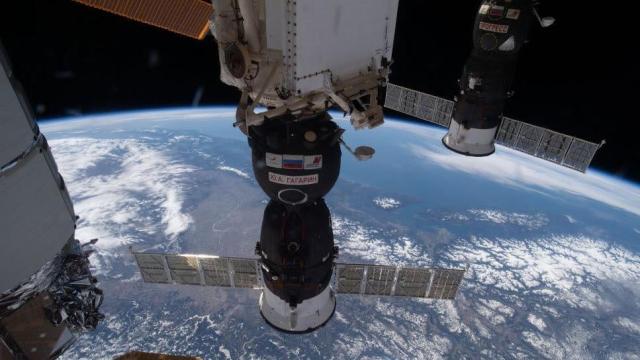Late last week, a routine thruster test of a Soyuz spacecraft continued for longer than expected, causing the ISS to shift by nearly 60 degrees. It’s yet another troubling sign that all is not well in the Russian segment of the orbital outpost.
The incident happened on Friday, September 15, as Russian flight controllers were running a thruster firing test of the Soyuz MS-18 spacecraft, which arrived at the ISS in April. The test was being done in preparation for the departure of cosmonaut Oleg Novitsky and a Russian film crew consisting of actress Yulia Peresild and film director Klim Shipenko.
When the test window ended, however, the thruster kept on firing, which wasn’t supposed to happen. With the spacecraft still attached to the ISS, the “station’s orientation was impacted,” according to Roscosmos.” The Russian space agency said attitude control “was swiftly recovered due to the actions of the ISS Russian Segment Chief Operating Control Group specialists,”and that the “station and the crew are in no danger.” The departure of the Soyuz spacecraft went as planned a few days later, with the crew of three landing successfully on October 17.
The loss of orientation began at 5:13 a.m. EDT, and it took flight controllers 30 minutes to return the orbital outpost to a “stable configuration,” according to NASA. The incident was serious enough for NASA to declare an emergency, in which its astronauts were told to reference procedures in the crew’s “warning book,” as the New York Times reports. Russian news agency Interfax cited Vladimir Solovyov, flight director of the Russian segment, as saying the ISS shifted by 57 degrees.
A similar incident happened in July, when the newly docked Nauka module unexpectedly fired its thrusters, causing the ISS to shift by 540 degrees. It was one of the most serious episodes to have occurred in the space station’s 21-year history. A series of air leaks and signs of deterioration in the Russian segment suggest Russia is not doing its part to maintain the space station and that the ageing ISS is becoming increasingly unsafe.
NASA and Roscosmos are currently working together to figure out what happened on Friday. The New York Times cites NASA flight director Timothy Creamer as saying the thrusters may have “stopped firing because they reached their prop[ellant] limit.” In an email, I asked Jonathan McDowell, a researcher at Harvard-Smithsonian Centre for Astrophysics, what Creamer meant by that.
“The ‘prop limit’ was, I am led to understand, a software limit set for that burn,” rather than a limit having to do with dwindling fuel reserves, McDowell responded. “So the total amount of propellant used didn’t put the ship in danger of not being able to get home or anything like that…[so] I don’t think the situation was as concerning as the Nauka issue.”
That said, McDowell said incidents like this should not happen. This latest episode contributes “to the impression that the Russian segment of the ISS is being run in a rather cavalier fashion with insufficient quality control and safety checks on the thruster software and hardware,” he said.
At the same time, Russia is not being as transparent as it should be, McDowell added. “We know the burn lasted somewhere between 11 and 30 minutes but not exactly how long, and we don’t know how long it was meant to be in the first place, so that makes it harder to assess,” he said.
Roscosmos did not immediately respond to Gizmodo’s request for more information, such as a likely cause for the incident.
Russia’s contribution to this historic space project may be coming to an end. The country has threatened to leave the ISS by 2025 and build its own space station by 2030. The current U.S. plan is to support the orbital outpost through at least 2030.
More: Russian Space Junk Hit a Chinese Satellite in March, Evidence Suggests.
